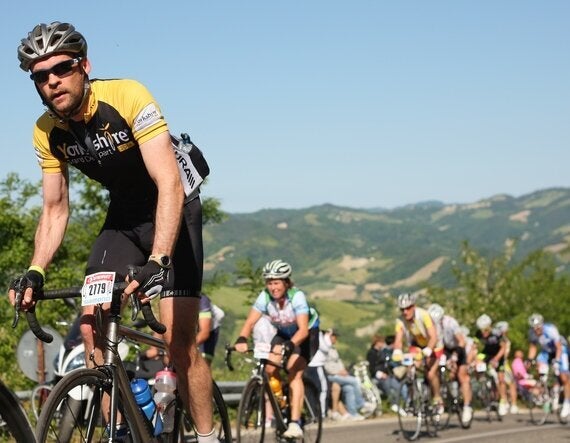
With a click of the gears it was over. Six months' training in rank British weather, the long solitary rides, the flight, the drive, the 4am alarm call, the force-fed pasta breakfast. For nothing, or so I thought.
I am an hour into the Nove Colli, a 200km mountainous bike race that mixes amateurs and semi-professional riders over the testing Apennine mountains in Italy.
The sun is on my back and my legs feel good. Then misfortune strikes. I change gear. Ping. I flick the gear shifter hopelessly as I realise that a small but important spring has broken, rendering my gears useless.
Full of despair I prepare to turn back, cycling with one gear and one failed objective, when I see a roadside mechanic. In hope over expectation, I show him my broken bike. He waggles the lever and his finger in equal measure and produces a rubber band, which he wraps around the shifter. Is that it? I ask myself as he and sends me on my way, with a cheery "vanno velocissime". To my surprise, his rudimentary but expert bodge works.
The Nove Colli is the oldest of Italy's 'gran fondos' - a semi-competitive mass participation cycle race. It first started in 1971 and has grown into a major event with 12,000 competitors. It is now attracting British riders. This year nearly 150 pale-faced Brits rode the Nove Colli, keen to sample something more exotic than the standard organised trips to the French Alps.
The race starts in the Adriatic town of Cesenatico, famous for its port designed by Leonardo da Vinci. The town is equally famous as the home of Marco Pantani. One of Italy's best-loved sportsmen, he delighted the tifosi with his audacious attacks in the mountains to win the Tour de France and the Giro de Italia, before breaking hearts with his tragic and untimely death in 2004. Cesenatico honours its hero with the Marco Pantani Museum, on the edge of the town.
The race starts at 6am where thousands of riders, pent-up with adrenaline and testosterone, are released onto the roads, like greyhounds out of the traps. For the first flat 30km my eyeballs are on stalks, as riders hammer down closed roads at 45km/h, five abreast. The safest way to ride is with the group, but the bends and roundabouts catch out riders who lie prostrate along the route, treated by medics.
I make it through this dangerous section. Now, the real challenge begins with the first of nine successive climbs deep in the Emilia-Romagna countryside, one of the richest and most fertile regions of Italy.
Payback is immediate: beautiful views across valleys of cherry orchards and Medieval villages, framed by the Apennine mountains. The rich colours of the green fields dotted with red poppies. This is what cycling in Emilia-Romagna is about.
The climbs aren't as long as the Alps or Pyrenees. Nor do they feature in the scores of '50-best' books of mountains to ride. But taken together the climbs of the Nove Colli are just as challenging, thanks to the Italian road builders who in their wisdom decided the best way over the mountains was to build straight rather than employing hairpins. One of the toughest climbs is the Barbotto, a regular in the Giro de Italia. Short, sharp and reaching 18 per cent, the Italians call it the muro.
Food is an important part of the Nove Colli. There are feed stations on the route, manned by lively volunteers. Food is a commodity in bike races, a way to keep fuelled and avoid the dreaded 'bonk', when a cyclist runs out of energy. Here, food is offered with a flourish: coffee, oranges, apples, mini pizzas, even slices of panettone are laid out on long benches; this fast food, the Italian way.
I crest Gorolo, the final climb of the ride. The road turns to the sea along a beautiful ridge and then down into Cesenatico.
The town is alive; spectators, bands and sponsors all feed off this annual race. It is a colourful and noisy welcome back after the peace of the mountains. As I coast over the finish line I glance at my gear shifter. For eight hours the rubber band has been the ride's savour. It has worked perfectly, helping me finish one of the hardest one-day bike rides in Europe. Vanno velocissime.
There is a postscript to this story. The next day I take my bike to a local bike shop. I figure it will be easier to get my Campagnolo gears fixed in Italy than at home. I am served by a man in his 50s, slim yet robust in stature. He explains at length how he is going to fix my bike. On collection he introduces himself as Marcellino Lucchi, bike shop owner and former Italian motorcycle champion. Only in Italy.

Getting there
There are flights from major UK airports to Bologna. From here it is a 1h15m drive to Cesenatico.
Where to stay
Giro Hotels is a network of 13 three- and four-star hotels in Cesenatico. They cater for the needs of cyclists with secure bike storage, maintenance and excellent food.
Registering for the Nove Colli
The race takes place in May. Registration opens in November.

Photographs used with the kind permission of Sportograf.